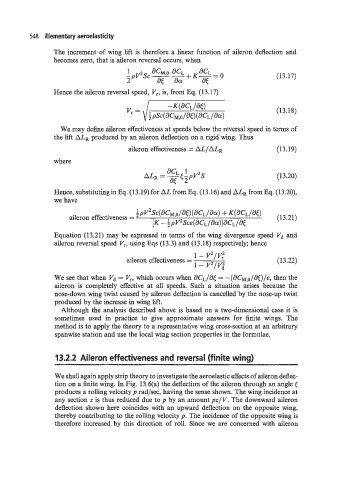Page 567 - Aircraft Stuctures for Engineering Student
P. 567
548 Elementary aeroelasticity
The increment of wing lift is therefore a linear function of aileron deflection and
becomes zero, that is aileron reversal occurs, when
(1 3.17)
Hence the aileron reversal speed, Vr, is, from Eq. (13.17)
(13.18)
We may define aileron effectiveness at speeds below the reversal speed in terms of
the lift ALR produced by an aileron deflection on a rigid wing. Thus
aileron effectiveness = AL/ALR (13.19)
where
(1 3.20)
Hence, substituting in Eq. (13.19) for AL from Eq. (13.16) and ALR from Eq. (13.20),
we have
Equation (13.21) may be expressed in terms of the wing divergence speed Vd and
aileron reversal speed V, , using Eqs (1 3.3) and (1 3.18) respectively; hence
1 - V’/V?
aileron effectiveness = (13.22)
1 - V’/Vi
We see that when V, = V,, which occurs when aCL/at = -(acM,o/at)/e, then the
aileron is completely effective at all speeds. Such a situation arises because the
nose-down wing twist caused by aileron deflection is cancelled by the nose-up twist
produced by the increase in wing lift.
Although the analysis described above is based on a two-dimensional case it is
sometimes used in practice to give approximate answers for finite wings. The
method is to apply the theory to a representative wing cross-section at an arbitrary
spanwise station and use the local wing section properties in the formulae.
13.2.2 Aileron effectiveness and reversal (finite wing)
We shall again apply strip theory to investigate the aeroelastic effects of aileron deflec-
tion on a finite wing. In Fig. 13.6(a) the deflection of the aileron through an angle t
produces a rolling velocity p radlsec, having the sense shown. The wing incidence at
any section z is thus reduced due to p by an amount pz/ V. The downward aileron
deflection shown here coincides with an upward deflection on the opposite wing,
thereby contributing to the rolling velocity p. The incidence of the opposite wing is
therefore increased by this direction of roll. Since we are concerned with aileron

